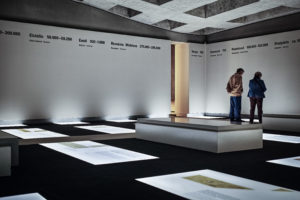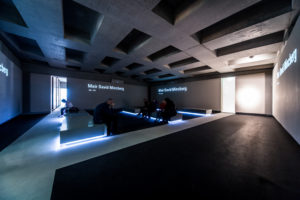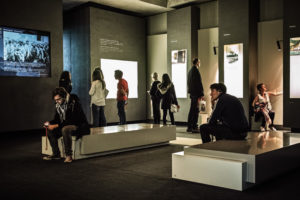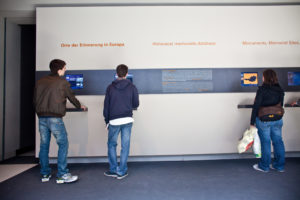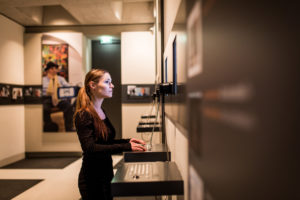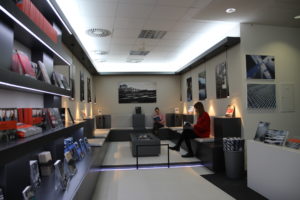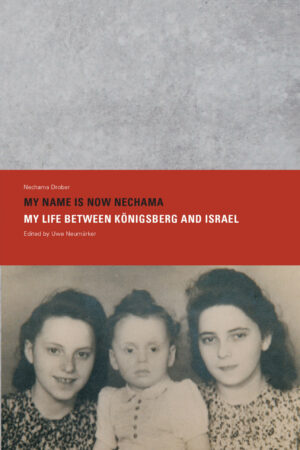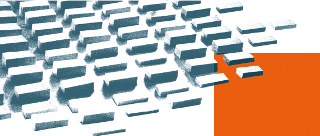- Cora-Berliner-Straße 1, 10117 Berlin
Important information about visiting the exhibition
Opening hours
Tue – Sun 10 am – 6 pm
Last admission 45 minutes before closing time
Waiting times
The length depends
of the day’s events.
Over the times you can
inform on site.
Closing days
Always closed on Mondays (except 25.05., 29.12.),
Nov 16-23 and Dec 24-26 closed and 31 Dec. closed from 4 p.m.
CONTACT
For questions:
+49 30 26 39 43 – 36
besucherservice@stiftung-denkmal.de
Note
+ + + Due to renovation work, the exhibition under the field of stelae will be closed from January 12, 2026 up to and including April 30, 2026. + + +
If you need an elevator, please contact us.
Access to the exhibition is via a security gate, but there may be waiting times.
- We ask for appropriate behavior in the exhibition.
The reading room closes 45 minutes before the exhibition closes.
Exhibition tour
The exhibition begins with an overview of the Nazi terror policy from 1933 to 1945. A line of text and images depicts the persecution and murder of European Jews in order to be able to classify the contents of the following four thematic rooms. From the front wall of the opening area of the exhibition, visitors are confronted by six large-format faces. These portraits represent the six million Jewish victims.
The focus of the first themed room is on diary entries, letters and final notes taken during the persecution. Few of the murdered Jewish children, women and men could leave testimonies of their personal suffering. The diaries and farewell letters, which are often only preserved in fragments, highlight their experiences, feelings and actions in the face of violence and deadly threats.
This personal level is supplemented by a circulating volume which gives the number of victims for the European countries concerned within the 1937 borders. There are no traces of most of the people deported to extermination. Between 5.4 and almost 6 million Jews have been murdered in Nazi-dominated Europe. The range of figures is based on documents of the perpetrators and statistical surveys of the then twenty, today twenty-eight European countries from which the murdered came. This tradition, too, is incomplete. The perpetrators deliberately removed references to the murdered and their life circumstances; documents were destroyed or lost in the war.
On the basis of 15 Jewish family fates, different social, national, cultural and religious worlds are presented in this room. This illustrates the contrast between life before, during and after persecution, the destruction of this culture and the loss it entails. Photos and personal documents report the dissolution, expulsion and destruction of these families and their members.
The stories of Jewish families reflect the diversity of the worlds of European Jews before the Holocaust. Religious traditions were cultivated and passed on in the family. But the stories shown here also highlight the change that European Jews have undergone since the rise of religious and political reform movements in the 19th century. The changes between the generations are clearly visible in the portraits on display. In the face of the rise of anti-Semitism in the 1930s, the family, along with the Jewish community, offered important support for the persecuted. The German occupation of large parts of Europe tore apart almost all family ties, and up to six million people were killed in the mass murder. The few survivors have often lost their entire kinship. Their lives and cultural environment were wiped out. In contrast to the family histories on display here, not even individual photographs were preserved.
In the room of names, the dramaturgical highlight of the exhibition is the reading of short biographies of murdered or missing Jews. Here, an attempt is made to dissolve the incomprehensible number of six million Jews killed in their abstraction and to free the victims from their anonymity. Each person’s name, year of birth and year of death are simultaneously projected onto the four walls.
The National Socialists and their helpers snatched millions of Jews from their homeland, culture and world. Their mortal remains usually did not find a burial place, but were buried or burned. Little today bears witness to the existence of those murdered. In many cases, their names are no longer even known. Testimony from witnesses and the results of historical research make it possible to commemorate the dead individually. Reconstructing the biographies is a difficult and lengthy process. The information presented in this room is in line with the current state of knowledge. But the search continues. The reading of the names and life stories of all the victims in the form presented here would take about six years, seven months and 27 days.
The creation of the sound recordings in the Romm of Names is complex. But because as many names and information about victims as possible are to be preserved from oblivion and the memory of those murdered is to be kept alive in this way, the “Promotional Circle Memorial to the Murdered Jews of Europe” has kindly agreed to co-finance the production with its donations.
In the foyer area, visitors can research the biographies of victims of the Holocaust themselves in the database on the Room of Names.
In addition, the seven extermination camps and the mass shooting of Babij Jar near Kiev are depicted in photos and explanatory texts on eight narrow steles. Listening stations also allow contemporary witnesses to have their say. One hears reports and memories that relate to these eight places.
The portal provides information about more than 550 memorials, museums and monuments in 35 countries through historical photos and, above all, through up-to-date visual material. In addition, the online portal provides detailed background information on the countries, their history during the Second World War and the remembrance cultures that developed there after 1945. The memorial portal is thus considered to be unique on a European level because it not only marks the places, but also informs about the historical contexts and the very different forms of remembrance.
Due to many enquiries from visitors, the »Information Portal to European Sites of Remembrance« has been accessible at www.memorialmuseums.org since summer 2011.
Since January 2008, the online version of the »Gedenkbuch(es) – Opfer der Verfolgung der Juden unter der Nazialistischen Gewaltherchaft in Deutschland 1933 – 1945« with over 159,000 entries for individual research has been available in the back area of the foyer. The database of the Federal Archives enables visitors to search specifically for names, places of residence, birth, deportation and death dates of Jewish victims. For the online version of the memorial book, the letters from relatives of the murdered, researchers and interested private individuals received by the Federal Archives since its publication in 2006 have been evaluated and taken into account. Compared to the printed version, the online version contains 10,000 newly researched names. These include, for the first time, the previously known names of about 7,000 Polish Jews deported from the German Reich to Poland in 1938/39. Furthermore, the results of the work on the project »List of Jewish Residents in the German Reich 1933 – 1945« have been incorporated into the online presentation. Almost 1,000 sources from institutions in Germany and abroad were evaluated for this purpose.
Special introductions to the work of the video archive can be booked via the visitor service.
You can find more about the Interview Project of the Foundation »Speaking in Spite of Everything« here. The Foundation’s video interviews are available online at www.sprechentrotzallem.de (only in German).
The reading room can be visited during the opening hoursof the place of information.
Visitors to the exhibition have the opportunity to linger for a moment after their tour and to take a look at the various publications of the Foundation Memorial to the Murdered Jews of Europe. Of course, these can also be purchased on site.
Contact: Tel.: +49 (0) 30 – 200 766 50 / E-Mail: info[at]stiftung-denkmal.de.
The designer of the exhibition Dagmar von Wilcken
When designing the exhibition spaces, Dagmar von Wilcken intended to integrate the content concept into architectural specifications in order to achieve an aesthetic unity of both elements.
In the Information Centre, the steles of the monument find a formal continuation, but here they leave their abstract level and serve as information carriers. The grid and the formal language of the Field of Stelae are quoted by taking up and varying their original appearance in a modified form. In each of the four exhibition rooms, this metamorphosis looks different. This makes it clear that the visitors are in a distinctive place, namely below the Memorial to the Murdered Jews of Europe. The functional transformation of the stele into an information carrier creates a formal link between the Field of Stelae and the Information Centre, a transition from the abstract level to the level of concrete content.
In the first exhibition room, quotations from the victims’ own testimonies and the representation of the European dimension of the Holocaust are shown. The quotations can be read on glass plates embedded in the floor and illuminated from below. Each of these glass plates »reflects« an above-ground stele in the ground in size and placement – as a virtual continuation of the above-ground Field of Stelae.
In the second room, the stelae of the field »penetrate« the Information Centre from above. They show 15 life stories – representative of the fate of many Jewish-European families. The stelae, which seem to protrude through the ceiling into the Information Centre up to a height of 0.70 m, are in turn impermeated by these individual life stories. The backlighting of the exhibits illuminates the room. In addition, each hanging stele throws light in its ground plan onto the floor and reflects it indirectly into the room.
The third room, the Room of Names, is empty except for three benches. In contrast to the other three themed rooms, the grid of the Field of Stelae is only quoted by the format and placement of benches.
In the last of the four themed rooms, in the Room of Sites, the stelae reach out of the walls towards the exhibition visitor. The focus is on the geographical dimension of the Holocaust. The broad sides of the cubes serve as projection surfaces for historical film and photographic material.
Dagmar von Wilcken, born 1958, studied object design and visual communication, 1987 diploma at the Hochschule der Künste in Berlin, freelance exhibition designer, numerous exhibitions for the Bauhaus Archive Berlin, 1995 to 2004 design of the permanent exhibition »Traces of Injustice« for the Documentation and Information Centre DIZ Torgau, numerous commissions from the Foundation Neue Synagoge – Centrum Judaicum Berlin, including the exhibition »Jews in Berlin – 1938 to 1945«, the overall design concept for the exhibition in the »Information Centre« of the Memorial to the Murdered Jews of Europe from 2001 to 2005 and for the special exhibitions »›What was deemed fully legal at the time …‹ – Soldiers and civilians tried before the courts of the military«, »Fire! Anti-Jewish Terror on Kristallnacht in November 1938« and »The Unknown Extermination Camp at Chełmno nad Nerem – History and Remembrance«.
Traffic

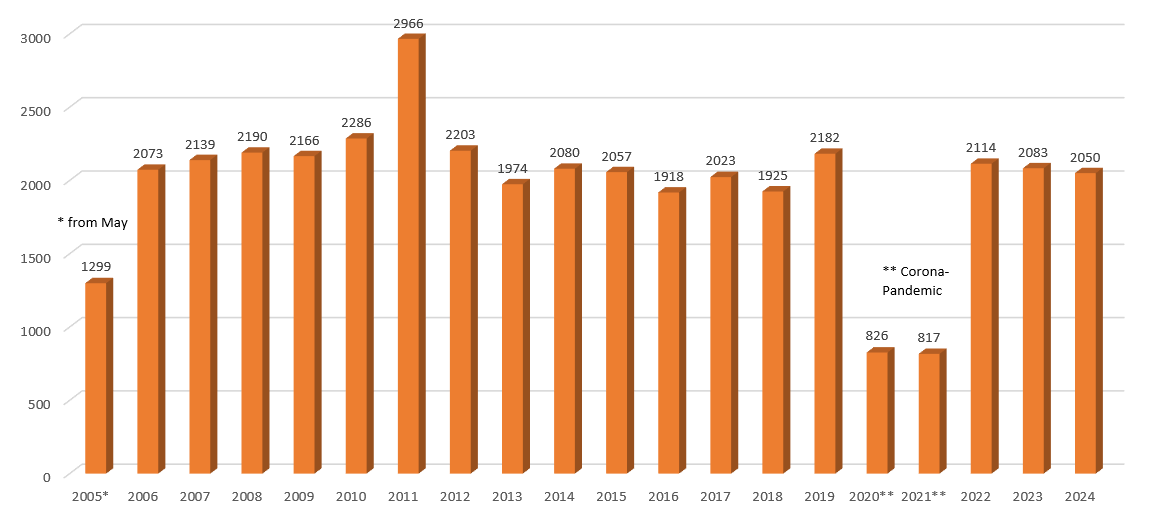
Publications available in the place of information
Offers for visitors
Frequently Asked Questions
Entrance is cost-free, but we of course welcome donations. There is a donation box at the exit of the Information Centre. Donations are used for maintenance of the Information Centre. It is also possible to send a donation by bank transfer.
We recommend about one hour for a tour of the exhibition. If you use an audio guide for the tour, you will require about 90 minutes.
In planning your visit, please take into account the waiting time for entry. We give precedence to registered groups that have reserved a time for the Information Centre, so this may require you to wait. Please appreciate that this is necessary.
Yes. For your own safety, you will pass through a security check zone when you enter the Information Centre. Dangerous objects should be deposited at the entrance for the duration of your visit to the exhibition. In order to avoid a long wait, it is best not to have much baggage.
Yes. In the Information Centre there is a free cloakroom.
Due to the safety regulations and due to space constraints, it is not possible to carry and store bags larger than conventional hand luggage (dimensions approx. 55x40x20 cm).
Tour groups are kindly asked to consult the visitor service about the amount of luggage carried before visiting: besucherservice@stiftung-denkmal.de,Tel.: +49 (0)30-26 39 43 36.
Luggage lockers are located near the monument at Potsdamer Platz and Friedrichstraße stations, or at the main railway station.
No. Suitcases and small bags may not be taken to the exhibition due to security checks. Lockers are available nearby at Friedrichstraße station and Potsdamer Platz.
Yes, the audio guide costs 3 euros, reduced 2 euros.
At the cash desks you can pay in cash, by EC and by credit card (Visa, Mastercard).
Only school groups receive the discount. The price for school is 2 euros.
Yes, you may take photographs, but without using a flash.
Out of consideration for other visitors, we ask you to turn off your cell phone during your visit to the exhibition.
External travel guides, tour guides and teachers are asked to kindly refrain from conducting any tour through the Information Centre. Our visitor consultants are available for questions during a tour of the exhibition and will be happy to assist you.
Coaches can stop at the marked parking spaces in Hannah-Arendt-Straße to get in and out of the area. To park the coaches, please also use the designated parking spaces in the street of 17 June (both sides of the street between the Brandenburg Gate and the Soviet Memorial).
If you lose or find something, please contact the reception desk in the Information Centre.: Tel.: +49 (0) 30-200 766 0.
The Memorial to the Murdered Jews of Europe Foundation supports teachers in preparing for the visit with a school class. The pedagogical program includes various guided tours as well as workshops lasting several hours, specially designed for students. We offer teachersmaterials for the preparation and follow-up of the visit with a school class.
We recommend visiting the exhibition in the Information Centre for students from 14 years.
For bookings, please use our booking requestor contact our visitor service: Tel.: +49 (0) 30-26 39 43 36
For families with young children, a changing table is available in the disabled toilet. Strollers can be borrowed from the reception for the duration of the visit.
People with pushchairs can use the elevator to get to the Information Centre.
Please contact a visitor supervisor at the entrance stairs.
We recommend a visit for young people from 14 years of age.
All exhibition texts in the Information Centre are presented in German and English.
Audio guides can be borrowed to provide translations of the exhibition texts in the following languages: French, Hebrew, Italian, Polish, Portuguese, Russian, Spanish. (see audio translation)
Every 1st Sunday of the month there is a free guided tour in English at 2 pm and every 3rd Sunday of the month there is a free guided tour in German at 2 pm. Group accompaniments can be booked in the following languages: German, English, French, Hebrew, Italian, Dutch, Polish, Russian, Spanish and many other languages on request. (see group tour)
The leaflet for the memorial is available in 21 languages.
The Field of Stelae can be traversed by wheelchair. It has 13 marked axes of entry whose slope angle is 8% maximum. They are marked with specially grooved paving stones and floor pictograms (wheelchair symbol) on the border to the public sidewalk.
The Information Centre is accessible to wheelchair users and has no barriers of any kind. In order to use the elevator, please contact our visitor consultant in the entrance area an the stairway. Wheelchairs can be borrowed at the reception desk in the Information Centre for the elderly or persons with impaired mobility for the entire duration of their visit.
For safety reasons, only a maximum of 6 wheelchair users can visit the exhibition at the same time. We ask for your understanding. For questions contact our visitor service: besucherservice@stiftung-denkmal.de, Tel.: +49 (0) 30-26 39 43 36





